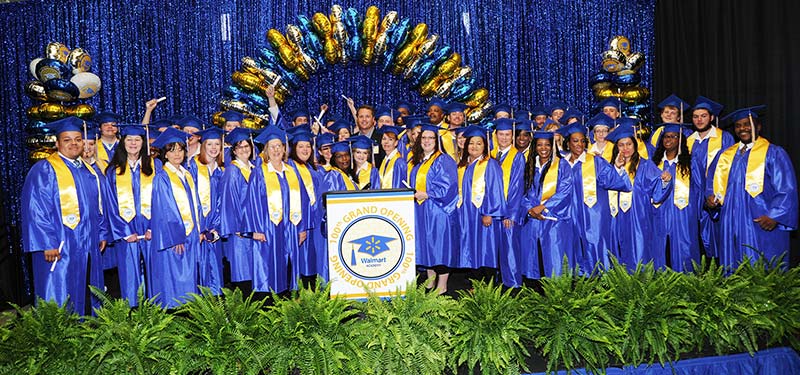By Donald Fan

Avoid the pitfalls that could impact the career growth of women and people of color in the digital age
The future of work and the underlying global reskilling challenge were among the hottest topics discussed at the World Economic Forum at Davos in 2019. The discussion addressed the emerging skills gaps arising from greater use of artificial intelligence (AI) and automation. With the unprecedented speed of change and uncertainty technology is causing, more and more organizations and chief learning officers are strategizing to deal with this new challenge as a business imperative and competitive advantage.
In this article, I want to zoom in on and debunk some related myths, so organizations will intentionally include and engage diverse talent, while putting together a blueprint and roadmap for reskilling and upskilling efforts.
Myth No. 1: Women and people of color will compete equally in the digital transformation.
Debunk: Automation-led job loss will impact women and people of color more significantly.
While digital technology and automation speed up to raise productivity, cut cost, and outperform the competition, they also present a real human threat to today’s workforce in various forms like job loss, skill scarcity, and a severe talent war in a tight labor market. During this disruption, women and people of color workers are more likely to fall victim.
According to a McKinsey study, job losses for African Americans in the U.S. could affect 4.5 million individuals—10 percent more than the general population—in the next ten years, and globally, automation could force more than 100 million women to find new occupations by 2030.
In his recent book, Tools and Weapons: The Promise and the Peril of the Digital Age, Microsoft President Brad Smith writes, “When your technology changes the world, you bear a responsibility to help address the world you have helped create.” To prevent growing inequality in the digital shift, organizations should be intentional in fostering an inclusive and enabling environment, where diverse talent enjoys the fair share of reskilling, upskilling, new technology adoption, and development opportunity.
In the meantime, organizations morph their expectation of employees from efficiency to ability in broadening value creation by exploring new frontiers. Given future-proof competencies and new opportunities for everyone, organizations can maximize the full potential of an agile and diverse workforce to win the competition.
Take my employer, Walmart, as an example. In the past few years, the company has committed $2.7 billion to workforce training and wages. Diverse employees are encouraged to take advantage of the opportunity to increase their learning agility. In just three years, more than 1.1 million frontline employees have graduated from the 200 Walmart Academies, acquiring the new knowledge, skills, and abilities they need to succeed in the competitive retail landscape of the future. Among the million graduates, 62 percent were female; 37 percent, people of color; and 36 percent, over the age of 45.
Centering around its vision of “Everyone Included,” Walmart’s Global Office of Culture, Diversity & Inclusion extends the inclusive leadership curriculum with a combination of workshops, training sessions, interactive learning activities, and a video library with discussion guides to teach its managers how to foster an inclusive culture, lead a diverse team, and make value-based and bias-free decisions. These systemic endeavors aim to integrate diversity, equity, and inclusion into the talent career cycle and ensure that everyone enjoys fair chances to fulfill their full potential in the workplace.
Myth No. 2: Automation and machines will replace humans and make jobs disappear.
Debunk: Automation means that jobs will be done differently, not that jobs will disappear.
In the report “The Future of Jobs 2018,” the World Economic Forum calculated that while 75 million jobs will be displaced worldwide through automation between 2018 and 2022, as many as 133 million new roles could be created. According to McKinsey’s research, currently demonstrated technologies could fully automate only about 5 percent of jobs. A range of additional labor demands of between 21 percent to 33 percent of the global workforce (555 million and 890 million jobs) by 2030, more than offset the number of jobs lost.

Rather than being lost or gained, many jobs will be changed, as machines complement human labor in the workplace.
Organizations need to provide employees with the skills to fulfill new roles, highlighting the need for reskilling at-risk workers. With various learning programs presented in the workplace, employees can choose the ones aligned with their career aspirations and learn to close gaps in their knowledge, skill, and ability. Keep in mind that, during the digital transformation, what we ultimately ought to protect is humans, not jobs.
While reassessing current jobs, what if we shift the focus of employees from executing routine tasks to identifying unseen problems and seeking breakthroughs? While machines take over repetitive tasks, employees can focus on serving customers, learning, and applying new skills in problem-solving.
Walmart has opened various channels to raise employee readiness for different roles. In a short period, the company has created 30,000 new jobs for its grocery pickup service. Today, the company offers the LinkedIn Learning platform with unlimited access to more than 14,000 online courses covering numerous subject areas, including business, technology, management, and many more. With mobile 24/7 access, employees enjoy the autonomy of taking classes wherever and whenever they want at their own pace.
Walmart also joins with IBM and the Consumer Technology Association’s Apprenticeship Coalition to help its employees train for new IT jobs. The program enables participants to learn by doing and facilitates employee growth from learner, with a classroom understanding of a topic, to practitioner, skilled at capability delivery, to expert, with the ability to lead.
Myth No. 3: Reskilling and upskilling training eclipses the quest for formal education.
Debunk: Formal education lays a solid foundation for career growth and lifelong learning, and it can’t be replaced by skill training.
In a recent Harvard Business Review article, Dr. George Kuh points out that “workplaces, societal institutions, and the world order are only going to get more complicated and challenging to navigate and manage, increasing the need for people with accumulated wisdom, interpersonal and practical competence, and more than a splash of critical thinking, analytical reasoning, and altruism.” He also notes that there are “no short cuts” to enabling people to deepen learning, develop resilience, and convert information into action. Reducing education to bolster productivity is shortsighted for many reasons. He expects that many learners from traditionally underrepresented groups will likely gravitate toward these shorter and less expensive training programs at the risk of delaying, or denying themselves, a foundational baccalaureate degree.
When we shift employee requirements from acquiring specific skills to laying a solid foundation for future growth, we help them increase learning agility and equip them with the capability to spot and solve unknown puzzles.
As a part of reskilling and upskilling efforts, organizations should consider making higher education for employees both accessible and affordable.
Walmart offers its employees a choice of flexible, online education programs from top schools and universities through its education benefit, Live Better U, a program characterized by four Cs—choice, cost, convenience, and coaching:
- Choice: When employees go back to school with Live Better U, they can choose from a variety of program options and enroll at the school that’s right for them.
- Cost: The company covers most (if not all) of the cost of tuition upfront through initiatives like its $1 a Day College program and free college preparation, high school diploma, and foreign languages. The company also reimburses the cost of required books and fees.
- Convenience: Flexible online classes, enable employees to learn whenever (and wherever) is best for them; take as many or as few classes as they want; and pick a program with a class format that works for them. Rolling start dates allow employees to get started whenever they’re ready.
- Coaching: Program participants receive free education coaching throughout their entire education journey. The coach helps out every step of the way.
Snce its inception in 2018, Walmart’s $1 a Day College program has served about 15,000 employees; 58 percent of the participant have been women and 42 percent, people of color.
Myth No. 4: Reskilling and upskilling efforts should only focus on teaching new tech skills.
Debunk: Reskilling and upskilling shouldn’t exclude learning soft skills and transformable competencies.
If reskilling and upskilling concentrate only on teaching digital and tech skills, the efforts will miss out on a broad base of employees, especially women and people of color.
With its analysis of changes in skill demand from 1988 to 2030, Deloitte concluded that the future of work is about humans. The skills in demand have evolved from work of the hands (manual labor), to work of the head (cognitive labor), to an emerging need for work of the heart (e.g., soft skills such as judgment, resolving conflict, and customer service).
Although robots and AI change the nature of work, augmenting both work of the hands and work of the head, humans will increasingly need to attend to nonroutine work of the head (e.g., generating insights) and work of the heart (e.g., collaborating with diverse teams to make complex decisions).
Historically, schools, universities and workplaces have mainly focused on developing and rewarding technical skills (e.g. data analysis). Therefore, the supply of employees with people skills is being outstripped by the growing demand. This report argues that investment in the following three areas will lead to a more skilled, satisfied, and engaged workforce: 1) skills, in particular, soft skills, 2) better designed, inclusive and diverse workplaces, and 3) greater flexibility.

Lynda Gratton and Andrew Scott, authors of the book “The 100-Year Life,” believe that we’re transitioning from the three-stage life, full-time education, full-time work, full-time retirement, to the multistage life where education, career, and retirement are blended. To live that life, we need to be healthy and more important, constantly learning. The fastest learners and the fastest at applying the new knowledge will live a fulfilling 100-year life.
Walmart urges it 2.3 million employees worldwide to be lifelong learners and promises the digital transformation to be “people led and tech empowered.” The company means to compete with technology, but win with people.
Teaching soft skills along with digital skills is essential in the reskilling and upskilling curriculum. Walmart Academy designs learning programs that are in line with the company’s transformation road map, global leadership competencies, employees’ career progression, and skills gaps. The learning journeys are tailored to meet both business and employee needs, and apply new technology to enable the desired outcomes. For example, the Walmart Academy adopts the digital solution, Virtual/Augmented Reality, to allow participants to enter 360-degree virtual representations of real-world scenarios, where they are asked to make choices based on what they see in the presented context. Through different ways of learning—a classroom setting, mobile training, virtual and augmented reality for an immersive experience, and reinforcement activities, the Academy fundamentally changes what, how, and where employees learn. It helps them become lifelong learners and fulfill their professional aspirations.
Raising the bar on development means raising the bar on a range of business and social outcomes. Using design thinking, growth mindset, advanced technology, and inclusive culture, organizations and HR executives can build the right solutions and learning experiences for everyone in the workplace to be well positioned to take on new challenges. These intentional efforts and practices can help us foster a competitive future workforce and turn “winner take all” into “no one left behind” in the digital era.

Donald Fan
Donald Fan serves as Senior Director in the Global Office of Culture, Diversity & Inclusion at Walmart Inc.






